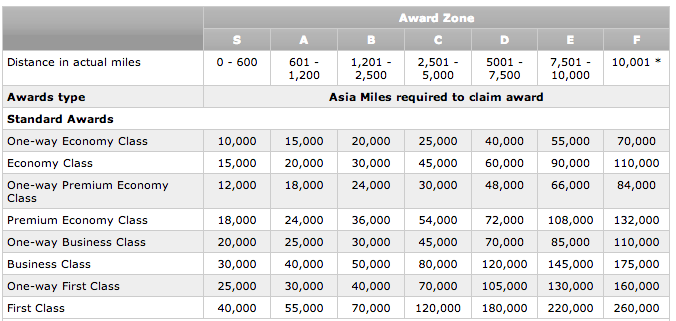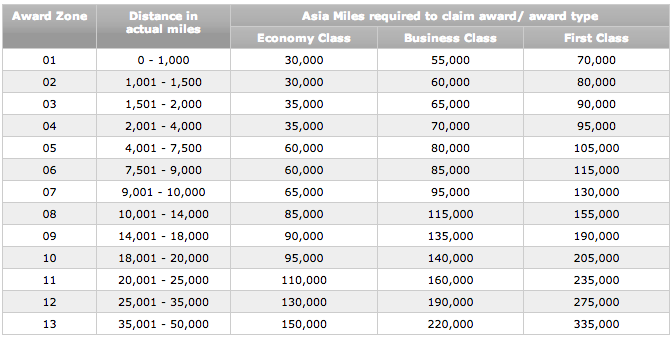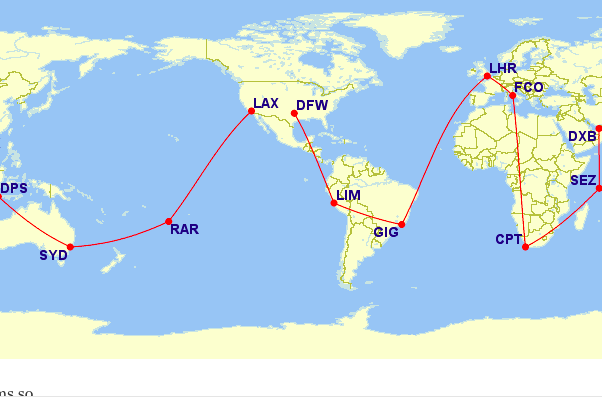Asia Miles is a transfer partner of Citi, Amex, and SPG 1:1, they have a decent award chart, and yet, there is very little information about them. And why not?! They have awesome redemptions available. And oh yea, they allow 4 stopovers!
Like any foreign airline, fuel surcharges can be an issue. But heck, that’s like nearly every airline nowadays.
This post will give the basics of the program, how to avoid fuel surcharges, and scoring big redemptions.
Asia Miles
(of Cathay Pacific & Dragon Air)
Asia miles is the Oneworld version of ANA. Maybe their award chart isn’t quite as strong, but it’s darn good. Plus, it allows 4 stopovers and a destination – that’s 5 stops on a round trip ticket.
Like ANA, Asia miles is a distance based program – the more you fly, the more you pay. This means that there are generally sweet spots
According to the Master Chart of Avoiding Fuel Surcharges, ITA says that a few airlines don’t have fuel surcharges at all. I assume Asia Miles will match this list for airlines to redeem on to avoid fuel surcharges:
- AirBerlin
- LAN
- TAM
- US Airways
- AA within the Americas
PLUS, non OW partners:
- Aer Lingus
- Alaska (only for economy)
- Air New Zealand only for HKG – AKL
You can always redeem on other partners, you just might end up paying a pretty penny for it. However, these are safer airlines to stick to.
Award prices
Their award chart is kind of confusing as they have two. One award chart for flights with Cathay, and one without. Each chart has different rules for stopovers.
Cathay Award Chart
Can/must include Cathay/Dragon Air and can include one partner airline:

May make two stopovers on roundtrip, or one on a oneway.
OneWorld award chart
When Cathay isn’t included or there are more than two partners:
My assumption is that this is also the award chart for the non OneWorld partners as well, like Aer Lingus and Alaska.
Rules:
- 4 stopovers (they say 5 because it’s 4 plus the destination – 5 stops)
- 2 open-jaws
You can make a maximum of five stopovers, two transfers and two open-jaws at either origin, en-route or turnaround point.
- Fuel surcharges:
Best Use:
Anything that doesn’t have fuel surcharges.
Europe trip – It looks like you could do a trip on Air Berlin to Europe and connect to Ireland with Aer Lingus as one of the stopovers.
South America, Central America, and the Caribbean – You wouldn’t be able to get too many stopovers in the Caribbean, as there is no hub down there to connect on. But you could do a stopover route involving South America with LAN and TAM for a very reasonable price.
Domestic? – The rules don’t really mention anything regarding stopovers in the home region. So I’m not sure if stopovers in your own country are allowed, but it may be worth asking about. If so, that would be an absolute steal. However, every other airline seems to restrict it. But if agents just go off rules, again, there’s nothing against it.
Booking Routes
I’m not too sure about AA flights yet using Asia Miles, but let’s assume they don’t have fuel surcharges, or you’re not concerned, or we’ll fly the safe airlines listed above when we can… Either way, I wanted to give some examples of pricing out a ticket.
What we’re going to do is compare the award charts above to GCMap, which will tell us the distances flown on each route, and then figure out the price in Asia Miles. In fact, I’ll back it up, and break it down.
- Check out the OneWorld Route Map
- Use GCMap to figure out how many flown miles the route you want to fly will be
- Compare to the award charts above
- Look for availability (on BritishAirways.com, Qantas, or ExpertFlyer)
- Book by calling Asia Miles or online for Cathay, British Airways or Qantas
For example…
Let’s take a basic round trip from New York to Dusseldorf (which you’ll find on the OneWorld map), and plug it into GCmap.
“JFK-DUS-JFK” is 7,498 flown miles. This obviously won’t include Cathay Pacific (as they are based in Hong Kong), so it will be priced on the “OneWorld award chart”.
The flight will fall into the fifth region, between 4,001 – 7,500 flown miles. This means that the flight will price out as:
- 60,000 miles for economy
- 80,000 miles in business class
- 105,000 miles in first class
These prices actually aren’t bad, especially for premium cabin. And if it’s an airline that doesn’t have fuel surcharges (like Air Berlin, which does that route), it’s a super great deal. But can we make it even better?
Yes. You can add one more stop. But you can pretty much connect all of Europe on Air Berlin/Nikki. Either go from hub to hub. Or from a hub to a destination that connects to another hub.
Hubs and focus cities:
- Berlin
- Dusseldorf
- Hamburg
- Munich
- Mallorca
- Stuttgart
- Vienna
- Salzburg
You can find routes out of any of these cities. So you could fly out of Dusseldorf to a city that would also connect to Vienna, and then connect to Vienna. Like Rome. Dusseldorf to Rome to Vienna.
Doing this you can hit almost any city in Europe without fuel surcharges!
Europe Stopovers:
Crazy awesome thing is that all intra-Europe flights on AirBerlin (or Nikki to/from Vienna) are going to be without fuel surcharges.
But there are some flights in Europe on British Airways that would have fuel surcharges.
However, there is a problem to adding stopovers in Europe: airport taxes. You can’t avoid them, but when you start adding stopovers you start adding on all these insane airport taxes. Not too sure what to do about that other than get the Barclay World Arrival card, find cheap airports, or don’t do stopovers/Europe.
By flying to Dusseldorf, I’ll obviously have to leave Dusseldorf and pay their taxes (unless I open-jaw), but also by adding Vienna as a stop, you’ll add the VIE airport taxes ($40?).
Think of the airport tax as the price of adding a stopover.
Back to the Europe stopover, thing.
We’re flying New York to Dusseldorf (stopover) on US Air, and now onto Vienna with Nikki/Air Berlin. The VIE airport will add $40. We can essentially do this process over and over, up to 5 stops!
To make things shorter, I’ll draw up a route.
New York – Dusseldorf – Vienna – Warsaw – Dublin – New York
Actually that’s only 4 stops (one more left), but let’s at least add it up on GCmap. (JFK-DUS-VIE-WAW-DUB-JFK).
8,899 flown miles, will make it 60,000 Asia Miles in economy + fuel on the intra-Europe flights + airport taxes.
Latin America/Caribbean Stopovers
The same concept applies here, except there are no fuel surcharges to worry about, and the airport taxes are much more minor.
The route above is New York – Cancun – Lima – Quito – Miami – New York. It’s 7,620 flown miles, which would bring the award price to 60,000 Asia Miles.
Is 60,000 Asia Miles great for this route?
Let’s compare what it would be on other airlines to Lima, Peru:
- AA = 35,000 miles (0 stopovers)
- US Air = 60,000 miles (1 stopover)
- Lufthansa = 60,000 miles (2 stopovers)
- Air Canada = 50,000 miles (2 stopovers)
- ANA = 38,000 – 43,000 miles (3 stopovers)
It’s a great deal given how many stopovers you get. The only one that really beats it, apples to apples is ANA. But nowadays, (with TAM now in OneWorld), availability is much better with Asia Miles.
The other advantage is just burning Citi points!
Conclusion
I know a lot of people have a ton of Citi points. Of the new transfer partners, this is one of the airlines that could be the most rewarding. Plus, there are a few great redemptions with stopovers and lack of fuel surcharges. For some this could be a great program.
Again, it’s not quite as good as ANA but they are in two different alliances. Even in Latin America they can feature different hubs. Plus, Citi points have been easier to come by.
I don’t have any great Citi bonuses to pimp right now, nor do I think Citi transfers are nearly as valuable as Amex or Chase… but it’s just another option for us miles collectors.
But the real advantage of Asia Miles is that it’s a transfer partner of Amex, Citi and SPG. While I don’t ever see a situation where I would use my valuable SPG points on Asia Miles (over AA), Citi and Amex are secondary currencies for me with frequent large bonuses. Accumulating enough miles is easy.
And obviously, 4 stopovers is a lot. I think it’s the most of any of the airlines. On this blog, that’s worth something.









Drew,
US aligned their fares with AA and now do have a YQ line on their fares. Perhaps you should check?
dern. Right. Forgot about that. I’ll have to edit that tonight.
Valuable post once again, Drew. By the way, what do you think about the other major airline partner for Citi points – Ethihad. As such it is difficult to get Ethihad miles as SPG is currently the only partner with transfer ratio of 1:1 (which even i wouldnt like to transfer to any airline for that matter). Now i think Citi points got sweeter with Ethihad (heck, i dont have citi card with citi points :(). It is a great airline and has very nice routes. I understand it is not difficult to get Ethihad award ticket using AA miles but then one could use Ethihad miles to directly upgrade from Economy to Business and from Business to First, from what i have read in the past. Any expert thoughts?
Well, I’m planning to cover all the new Citi transfers, so stay tuned. I’ll do some more digging.
Am I missing something? All of the intra-European flights you mention (ie. CDG-VIE) are Star Alliance – not oneworld.
Wow. Thanks. That is terribly embarrassing. No idea how I go on the other track. Good news I updated the info!
Great analysis Drew. Also, consider the BA program to evaluate for your Latin America/Caribbean Stopover.
BA = 47,500 avios (4 stopovers)
JFK-MIA 7500
MIA-UIO 1000
UIO-LIM 7500
LIM-CUN 12500
CUN-JFK 10000
Avios is definitely, an awesome use for latin travel!
Can you please explain the stopover rules in greater detail? Are stopovers allowed on one-way routes using a partner airline? Can you transit a region twice? Can you end in a different region?
For a simple example, can you fly sjd-dfw(stop)-tpa(destination)-dfw(stop)-cun? Using a stopover each time at DFW (my home airport)? This is 3900 miles and 35,000 miles which is pretty good for a domestic RT and 2 one-ways to Mexico.
It’s confusing. One stopover is allowed on oneways with the Cathay award chart.
Only roundtrips are allowed from the oneworld award chart.
And unfortunately, the routing rules don’t actually say a lot. So I assume you can transit in a region twice. And I assume you can’t end in a different region… but it doesn’t say. It requires more digging.
So I don’t think you’ll be able to open jaw returning to a different country. However, SJD and CUN are both in Mexico, so that would fall into those rules.
I appreciate all your post, but this is a drop off in quality for you. Why all the questions and assumptions? One of your strengths is that you test your assumptions and report. I count on you as a source but this feels like content, not knowledge.
Thanks for the feedback JB.
I recognize that this is much less informative, but I would like to explain.
See this blog, while bringing in a whole $1,000 in July, started as a hobby. So I try to write about what I’m excited about. And since I’ve never actually used Asia Miles, and they don’t actually have very many written rules, this is what I found in my personal research. I decided to check out the new citi transfers, and this is some of my research.
Similarly, other good content on United or BA, they started as hobbies. So if you read the first posts on the subject, they were much more watered down. But as I booked tons of stopovers my posts on that subject got better and more complete as my knowledge got more complete.
Same with Asia miles.
So yes, this post is not nearly as complete as other posts. But it’s not a reflection of the direction of the blog, it’s a reflection on how often I actually use Asia Miles. Which so far is never. And maybe if I rake in enough Citi miles, I’ll dig deeper or actually take a trip.
Drew
Hello Drew,
I like your posts. They are detailed and to the point. And one thing that distinguishes you from most other travel bloggers is that you bother to answer reader questions. I came here and read your other posts because Cathay is the only airline that would allow four/five stopovers, which I have. Any insight you can share would be most appreciated.
Here’s the desired routing: SIN-LHR, LHR-YYZ, YYZ-DSM, DSM-BHM, BHM-SFO, SFO-SIN.
I count four stopover cities: LHR, YYZ, DSM, BHM, and SFO with one of them being the “destination”.
I have a little under 200k SPG points, and almost zero Citi points. Some UR points. I have some United points but that’s a moot point because they don’t allow that many stopovers, which is critical for this trip. How can I maximize my transfers to Asia Miles?
Also, which OneWorld partner do you suggest I use to book this trip in a way that would minimize miles spent and fuel surcharges?
Many thanks in advance!
According to my (not yet too extensive) own research, on some domestic Australia as well as trans-Tasman flights and flights to Papua New Guinea, there is no YQ on Qantas redemptions, mostly those not operated by QF mainline. Take SYD – CHC. No YQ, both one-way or round-trip. It’s operated by Jetconnect for Qantas. Maybe that’s why. Same as CNS-POM (operated by Qantaslink), althought still roughly 180 USD round-trip in other fees. But then there’s CNS-AYQ, which does charge about 30 USD YQ round-trip despite being operated by Qantaslink as well. Still one hell of a redemption at 20k +130 USD round-trip by the way, considering they sell it at 700+ USD at times and it’s the only choice on that route.
I don’t think this article is actually correct. If you book on one Partner airline only then you can use the first table. It is only if you use two partners (excluding CX) that you have to use the second table.
For oneworld Multi-Carrier Awards, if you using 3 or more airline partner,one of them must be Cathay Pacific or Dragonair?
Planning to trip from KUL-HYD. Asia miles require 20k. Are there any fuel charges? Transferring TY points would do? I don’t have Dragon air availability. Else I would look into AA redemption on BA site.
Thoughts?